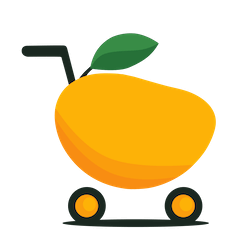Use the PVS Framework to turn your YouTube channel into a course-selling machine:
P = Psychology
V = Value
S = Seamless
I’ll break down each of the “P”, “V”, and “S” into 3 tables:
YouTube Psychology Sales Matrix
The Value Contrast Matrix
The Seamless Selling Playbook
Each table gives you plug-and-play strategies you can implement today to start converting your viewers into paying students.
YouTube Psychology Sales Matrix
Use this matrix to understand exactly which psychological principles convert casual viewers into eager students. Each trigger includes specific YouTube implementation strategies and common mistakes to avoid.
| Psychological Trigger | Psychological Mechanism | YouTube Implementation | When/Where to Use | Common Mistake to Avoid | Effectiveness |
|---|---|---|---|---|---|
| Scarcity | Creates FOMO through limited availability, activating loss aversion in the brain | “Only 50 spots available” with real-time counter showing remaining spots | Last 2 minutes of pre-launch videos; Community tab 48 hours before close | Creating false scarcity that damages long-term trust | ★★★★★ |
| Authority | Builds trust through demonstrated expertise rather than claimed credentials | Show process videos of achieving results before mentioning teaching method | First 90 seconds of any video; Channel trailer; About section | Claiming expertise without tangible proof | ★★★★☆ |
| Social Proof | Leverages human tendency to follow group behavior when uncertain | Feature student implementation videos rather than just testimonial quotes | Middle of videos after explaining what students will learn | Using anonymous or unverifiable testimonials | ★★★★★ |
| Loss Aversion | Exploits fact that pain of loss is psychologically 2x stronger than pleasure of gain | “Here’s what continuing without this knowledge cost me…” followed by specific examples | After providing substantial value in tutorial videos | Creating unnecessary anxiety without clear solution | ★★★★☆ |
| Reciprocity | Activates social obligation to return value after receiving something useful | Provide complete, usable template then mention advanced version in course | Immediately after delivering high-value free content | Giving low-value “bribe” expecting major purchase in return | ★★★★☆ |
| Identity/Belonging | Connects course to viewer’s desired self-image and community | “This is what separates amateur filmmakers from professionals who get paid” | When discussing industry standards or best practices | Creating elitism that alienates beginners | ★★★★☆ |
| Future-Pacing | Creates mental simulation of success, making desired outcome feel attainable | “Three months from now, you’ll be implementing this system for your first paying client” | During explanation of transformation timeline | Setting unrealistic timeframes for results | ★★★★★ |
| Problem-Agitation-Solution | Heightens awareness of problem before presenting solution | Demonstrate common mistake, show frustrating consequences, then reveal better method | Structure entire video with problem first, solution hint, then course as complete solution | Overemphasizing problem without adequate solution | ★★★★★ |
| Curiosity Gap | Creates information gap viewers want to fill (Zeigarnik Effect) | “The fourth step is what changes everything – I’ll show you that in the full course” | End of tutorial videos after delivering complete process minus key enhancement | Creating frustration by withholding too much core information | ★★★★★ |
| Exclusivity | Triggers desire to access what others cannot (scarcity + social status) | “Course students also get invited to our private monthly calls with industry experts” | When discussing course community and support elements | Overpromising exclusive access that isn’t truly valuable | ★★★★☆ |
–
The Value Contrast Matrix
This matrix helps you clearly position your course against alternatives like free YouTube content, competitor courses, and self-study options. Use it to create compelling sales messages that highlight your unique advantages.
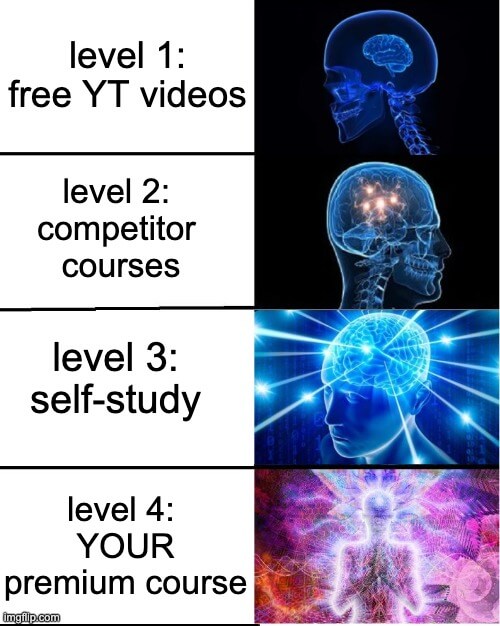
| Comparison Criteria | Your Premium Course | Free YouTube Content | Competitor Courses | Self-Study (Books/Articles) |
|---|---|---|---|---|
| LEARNING EXPERIENCE | ||||
| Structured Learning Path | ✓✓✓ Step-by-step system with prerequisite mapping | ✓ Random videos requiring self-organization | ✓✓ Some structure but often missing connections | ✓ Requires creating your own curriculum |
| Depth of Content | ✓✓✓ Advanced techniques with 45+ real examples | ✓ Basic concepts with 1-2 examples each | ✓✓ Moderate depth with limited examples | ✓✓ Potentially deep but theoretical |
| Practice Opportunities | ✓✓✓ 12 graded assignments with feedback | ✓ “Try this yourself” suggestions | ✓✓ 3-5 ungraded worksheets | ✓ Self-created exercises |
| Information Freshness | ✓✓✓ Updated quarterly with 2025 techniques | ✓✓✓ Latest tactics but fragmented | ✓ Often 1-2 years outdated | ✓ Typically 2+ years behind industry |
| SUPPORT & COMMUNITY | ||||
| Instructor Access | ✓✓✓ Bi-weekly group calls + direct messaging | ✗ Occasional comment replies | ✓ Email-only with 72hr response time | ✗ None |
| Peer Learning | ✓✓✓ Private community with 600+ active members | ✓ Public comments with no organization | ✓✓ Basic forum with limited activity | ✗ None unless self-organized |
| Accountability | ✓✓✓ Progress tracking with completion reminders | ✗ No tracking or follow-up | ✓ Basic module completion marking | ✗ Self-monitored only |
| Feedback Quality | ✓✓✓ Expert review of your specific implementation | ✗ Generic advice in comments | ✓ Templated feedback | ✗ None |
| RESULTS & OUTCOMES | ||||
| Completion Statistics | ✓✓✓ 68% finish entire program | ✓ Only 8-12% watch full playlists | ✓✓ 35% average completion rate | ✓ Unknown (self-paced) |
| Skill Verification | ✓✓✓ Industry-recognized certificate | ✗ No verification of learning | ✓✓ Certificate of completion | ✗ No formal recognition |
| Portfolio Development | ✓✓✓ 3 client-ready projects with feedback | ✓ Suggested projects without guidance | ✓✓ 1 guided final project | ✓ Self-directed work |
| Average Results | ✓✓✓ 85% of graduates report measurable improvement within 60 days | ✓ Inconsistent results, typically requires 6+ months | ✓✓ 62% report improvements within 90 days | ✓ Highly variable outcomes |
| INVESTMENT & VALUE | ||||
| Financial Investment | ✓ $X one-time investment | ✓✓✓ Free (ad-supported) | ✓ $Y often with upsells | ✓✓ $Z for books + resources |
| Time Efficiency | ✓✓✓ Optimized 8-week roadmap without fluff | ✓ 25+ hours finding the right videos | ✓✓ 12-week program with some redundancy | ✓ 100+ hours researching + organizing |
| Resource Quality | ✓✓✓ Professionally designed templates and tools | ✓ Occasional free downloads | ✓✓ Basic templates | ✓✓ Must adapt from general resources |
| ROI Timeline | ✓✓✓ Skills marketable within 8 weeks | ✓ 6+ months to assemble complete skill set | ✓✓ 3-4 months typically | ✓ 6+ months with uncertain outcomes |
| COMMON OBJECTIONS | ||||
| “It’s too expensive” | Investment returns through [specific outcome] within 60 days on average | Requires significant time investment to organize fragmented information | Often requires additional purchases for complete system | Hidden costs of trial-and-error learning |
| “I can learn this myself” | Saves 100+ hours of research and prevents costly mistakes like [example] | Requires extensive self-organization and identifying knowledge gaps | May still leave implementation questions unanswered | Difficult to know if you’re learning current best practices |
| “I don’t have time” | Streamlined system eliminates wasted effort on outdated techniques | Requires additional time finding and organizing the right content | Often includes unnecessary content to justify price | Requires significant time to synthesize information |
| IDEAL STUDENT | Career-focused learners seeking structured, proven path with accountability | Casual explorers or those with extensive self-discipline | Budget-conscious learners wanting some guidance | Self-directed researchers with strong organizational skills |
–
The Seamless Selling Playbook
Never sound “salesy” again with these proven templates for naturally mentioning your course. Compare ineffective promotions with natural “selling” that feels helpful rather than pushy.
| Content Type | Ineffective Promotion (Avoid) | Natural Integration (Use This) | Viewer Psychology | When to Promote | Explanation |
|---|---|---|---|---|---|
| Tutorial Video | “If you want to learn more about this topic, check out my course.” | “This quick tutorial shows one approach to [problem], but if you’re struggling with [specific challenge mentioned in comments], I’ve created a complete system in my course that includes [specific solution they need].” | Addresses actual viewer pain point and positions course as direct solution to their expressed need | After delivering complete value in the tutorial, typically in the final third of the video after viewers have received actionable information | Viewers who have already received value are more receptive to related offers that extend their learning |
| Process/Behind-Scenes | “I show all my secrets in my premium course.” | “What you’re seeing is the implementation phase of the framework I teach. Before reaching this stage, my students learn [foundational skill] which prevents the common mistake of [specific error].” | Creates natural curiosity about the complete process while demonstrating expertise | During moments when viewers might wonder about prerequisites or earlier steps in the process | Mentioning courses during knowledge gaps creates natural interest without interrupting the main content |
| Problem-Solution | “Having this problem? My course will solve it.” | “I’ve identified three main causes of [problem]: Today I’m showing you how to fix the first one. For those dealing with the more complex [specific situation], I walk through all three solutions with templates in my course.” | Provides immediate actionable value while establishing there’s a more comprehensive solution for complex cases | After solving a basic version of the problem but before addressing advanced scenarios | Viewers appreciate getting immediate help before being introduced to comprehensive solutions |
| Q&A Response | “I cover that in my course, here’s the link.” | “Great question about [advanced topic]. The short answer is [provide actual answer]. For those implementing this at scale, I created a detailed breakdown with examples in module 3 of my course where we address the nuances of [specific situation].” | Respects viewer by providing value first, then positions course as depth expansion rather than withholding information | Immediately after answering the question completely, when viewers might wonder about more complex applications | Providing the answer first builds goodwill and positions the course as a deeper resource, not a paywall |
| Case Study | “I teach how to get these results in my course.” | “The results we achieved came from implementing the [specific named framework]. While this video shows the outcome, what made the difference was the [specific element] stage we develop in week 3 of my course.” | Links visible results to specific, named methodology that feels tangible and desirable | After showing impressive results but before explaining the complete methodology | Viewers who are impressed by results are naturally curious about the specific process to achieve them |
| Tool/Resource Video | “For more tools like this, buy my course.” | “This template solves [specific problem]. I originally created it for my course students who were struggling with [common challenge]. They found it so useful that I wanted to share this version with you today.” | Creates reciprocity by giving value first, while subtly establishing there are more valuable resources in the course | After demonstrating the complete functionality of the free resource | Viewers who have already benefited from your free resource feel reciprocity toward paid offerings |
| Trending Topic | “Learn more about this trend in my course.” | “This [platform] update affects the [specific strategy] we’ve relied on. My course students received an updated [resource type] yesterday that addresses this change with [specific adjustment]. For everyone else, here’s what you need to know right now…” | Demonstrates responsiveness and ongoing value while creating FOMO regarding course updates | Early in the video when discussing the importance of staying current, then deliver valuable content | Mentioning course updates early creates interest without disrupting the main content viewers came for |
| Skill Demonstration | “Want to learn this skill? Take my course!” | “I’m demonstrating the advanced version of this technique today. If you’re wondering about the foundations, I’ve built a progressive system in my course that starts with [beginner concept] and builds to what you’re seeing here through [specific learning approach].” | Creates a clear mental model of skill progression with course as logical step in development | During complex demonstrations when viewers might feel overwhelmed by the advanced technique | When viewers experience the knowledge gap between beginner and advanced, they’re more receptive to structured learning resources |
| Livestream | “Don’t forget my course is on sale this week!” | “I see Mary asking about [specific challenge]. That’s exactly why I created the [named framework] in the course – I kept seeing students struggle with this. The key difference is [specific insight]… For anyone interested in the full system, the link is pinned in comments.” | Responds to actual viewer needs in real-time, making promotion feel like helpful service | In direct response to relevant viewer questions that align with your course content | Responding to specific questions makes your promotion feel like a helpful solution rather than an interruption |
| Audience Success Story | “Want results like this? Join my course!” | “What made Sarah’s implementation successful was how she adapted the [specific framework] from the course to her unique situation. Specifically, she used the [exact tool/template] to overcome [specific obstacle] that was holding her back.” | Provides concrete, replicable mechanism rather than vague promises, making success feel achievable | After showing before/after results but before explaining the detailed implementation process | Viewers who are impressed by transformation stories want to understand exactly how they can achieve similar results |
–
Why Sell Courses on YouTube?
YouTube has 2.53 billion monthly active users worldwide as of January 2025, making it the second most visited website globally, trailing only Google according to DataReportal.
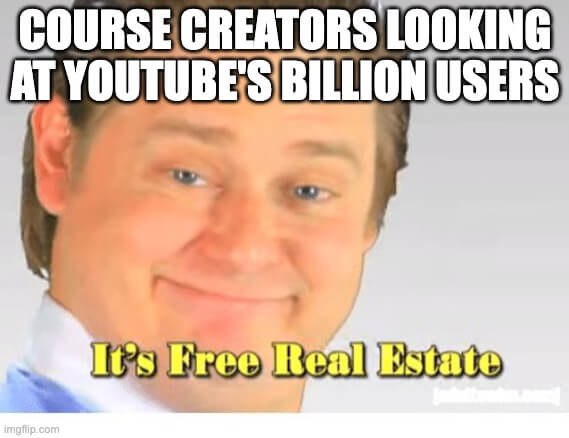
According to The Shelf and Statista, 77% of US internet users aged 15-35 regularly use YouTube. This creates a perfect opportunity for course creators to reach students where they’re already looking for education.
YouTube’s algorithm favors engaging educational content according to vidIQ, with the platform now prioritizing “user satisfaction indicators” like likes, comments, and survey feedback. Its video format allows you to show expertise, build trust, and create emotional connections with potential students.
Unlike traditional course marketplaces, YouTube lets you build an audience before creating your course. This helps validate demand and pre-sell your courses to people who already know, like, and trust you.
–
Choosing Profitable Course Topics for YouTube Audiences
The most successful course topics solve specific problems for clearly defined audiences.
Successful course creators are those who researched market demand before creating their courses… instead of relying on intuition or personal interests.
Start by analyzing YouTube search data using tools like TubeBuddy or VidIQ. Look for keywords with high search volume but moderate competition in your niche.
Pay attention to the comments sections of popular videos in your field to identify recurring questions and pain points. These are gold mines for course topic ideas that already have proven demand.
–
Setting Up Your YouTube Channel for Course Sales
Your channel structure serves as the foundation of your course business.
Channels with clear, topic-based playlists get more watch time than those with random video organization.
Create a channel trailer that addresses your audience’s main pain points in the first 15 seconds.
Viewers decide whether to subscribe within the first few seconds of watching a channel trailer.
Organize your content into strategic playlists that guide viewers through a journey toward your course.
E.g. Create beginner, intermediate, and advanced playlists with your course positioned as the complete system that ties everything together.
–
Value-First Approach
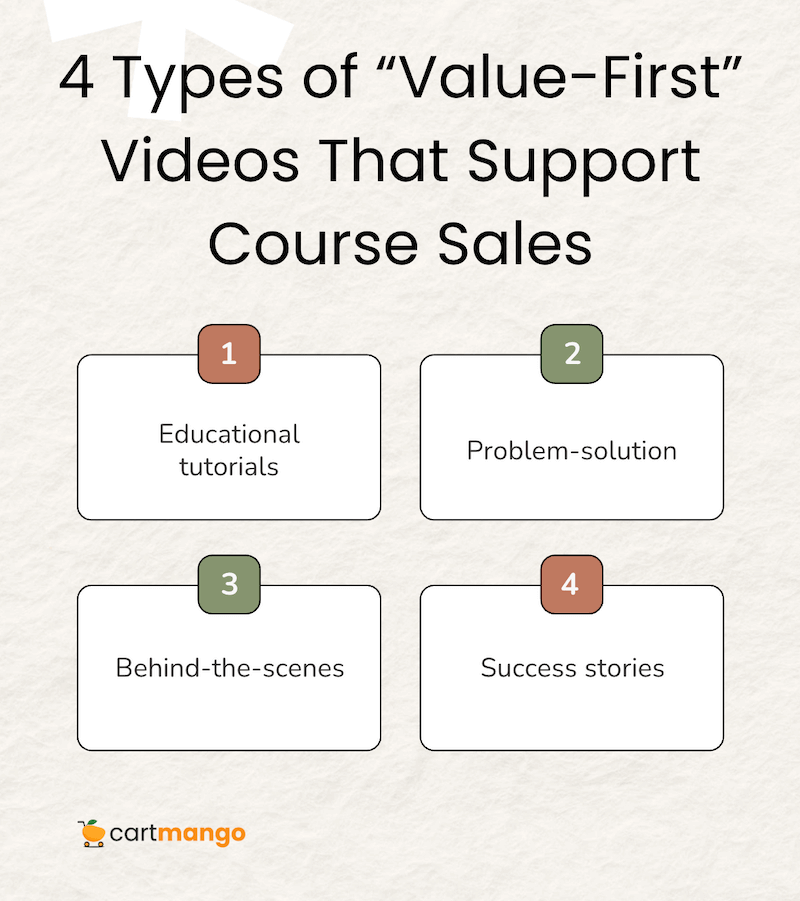
The most successful course creators follow a value-first approach.
Creators who give generously give away their knowledge for free (80%) and sell the remaining 20% (implementation systems, templates, and support) convert viewers at higher rates than those who withhold too much information.
Create 4 types of videos to support your course sales:
Educational tutorials that demonstrate expertise
Problem-solution videos addressing specific pain points
Behind-the-scenes previews of course content
Student success stories and testimonials
–
Creating High-Converting YouTube Videos
YouTube’s algorithm favors videos that generate high click-through rates and sustained watch time.
According to YouTube, 90% of the best-performing videos have custom thumbnails
Create custom thumbnails that include a clear benefit statement and emotionally compelling imagery. MrBeast, one of YouTube’s highest-earning creators, tests multiple thumbnail versions for each video before settling on the highest-performing option.
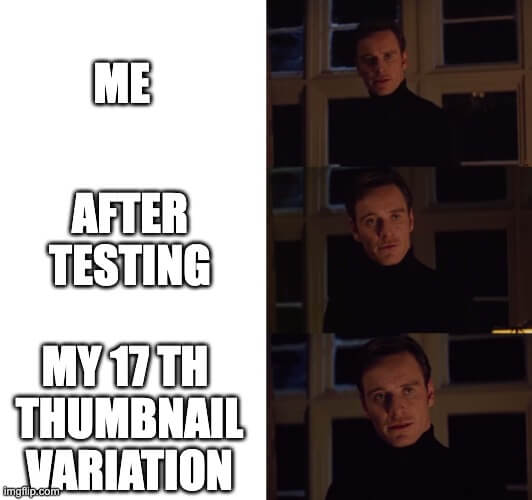
Structure your videos to maintain engagement using the PAS formula (Problem-Agitation-Solution). Start by identifying a problem, discuss why it matters, and then present your solution.
–
YouTube SEO for Course Creators
Research by Backlinko indicates that including exact-match keywords in your title can provide a slight advantage in search rankings. Their study found that videos with exact-match keywords in their titles tend to rank higher than those without.
Use tools like TubeBuddy or VidIQ to find relevant keywords with high search volume and moderate competition.
Include your target keyword in your title, first paragraph of description, and as spoken words in the first 60 seconds of your video.
Create SEO-optimized playlists around related keywords to increase your visibility in search results. Videos in well-structured playlists tend to get more views than standalone videos.
–
The YouTube-to-Student Pipeline
Converting viewers to students requires a clear pathway from free content to paid courses.
YouTube creators who build email lists typically get more course sales than those relying solely on YouTube.
Create lead magnets like cheat sheets, templates, or mini-courses that expand on your YouTube content. Lead magnets that solve a specific problem convert better than generic resources.
Design course landing pages specifically for YouTube traffic. These pages should maintain the same teaching style, vocabulary, and visual elements as your videos to create a seamless transition.
Consistent branding across channels increases conversion rates.
–
CartMango: Fast Course Selling for Solo Course Creators
While many cart/selling platforms require hours of setup time because of their complex nature, CartMango lets you set up and sell your course in just 1 minute.
CartMango is specifically designed for solo course creators, with features built exclusively for this group of folks.
It’s completely free throughout 2025, with no monthly fees or commissions. You only pay the direct processing fees from Stripe or PayPal.
You save the typical 5-10% platform fees or monthly/yearly fees that other platforms charge.
The result? Your profit margin increases.
Disclaimer: We’re the developers of CartMango. Click here to claim your free account and start selling in 1 minute.
–
Course Selling Models on YouTube
The 3 primary course selling models on YouTube are:
Evergreen
Launch-based
Hybrid (a combo of the above)
Evergreen models focus on creating content that continuously drives sales without time pressure. This works well for channels with steady traffic but typically has lower conversion rates.
Launch-based models create urgency through limited enrollment periods. They convert more but require more intensive marketing during open periods.
The hybrid approach combines both methods for maximum effectiveness.
–
Pricing Strategies for YouTube-Sourced Students
YouTube-sourced students often have different price expectations than marketplace buyers.
Binadox cites a study by Price Intelligently indicating that companies using tiered pricing experienced an average revenue increase of 98% compared to those with a single-price model.
When introducing your course price, always frame it in terms of the outcome value rather than the content value.
For example, “Double your freelance income” is more compelling than “10 hours of engaging video content and worksheets” or “How to freelance”.
–
More YouTube Features for Course Promotion
YouTube Live
YouTube Live works really well for selling courses.
When you go live, you connect with viewers in real-time, which builds trust much faster than regular videos. Try using live streams to answer questions about your course, kick off enrollment periods, or show sample lessons. The direct interaction helps viewers feel more comfortable buying from you.
YouTube Shorts
YouTube Shorts can help you reach brand new people who might buy your course.
Since these short videos appear in the Shorts feed, they often reach people who don’t already subscribe to your channel. Make quick 30-60 second videos showing specific benefits of your course or teaching a quick tip that leaves viewers wanting more.
Community
Don’t forget about the Community tab on your channel.
This feature lets you stay connected with subscribers between your regular video uploads. Share updates, poll your audience about their challenges, or post sneak peeks of your course content.
Regular community posts keep your channel active and your audience engaged, making them more likely to buy when you launch a course.
–
Analytics and Optimization
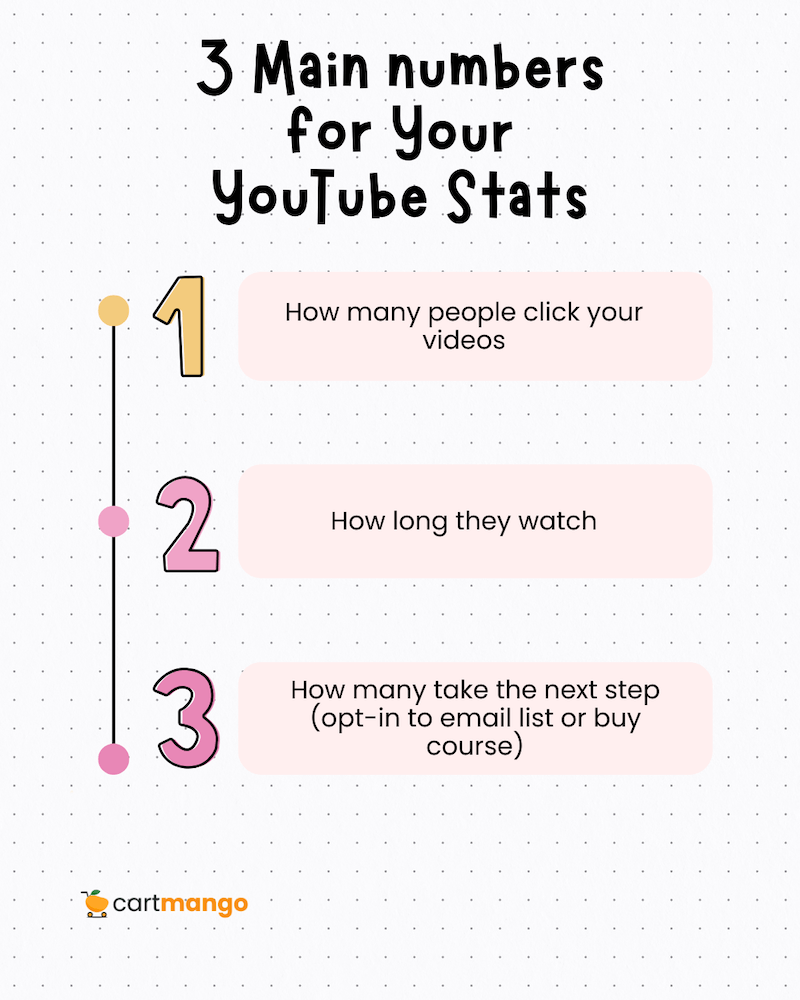
Pay close attention to 3 main numbers in your YouTube stats:
How many people click on your videos when they see them
How long they watch
How many viewers take the next step by signing up for your email list or buying your course.
These numbers tell you if your videos are working to sell courses.
Add special tracking links to your course mentions in video descriptions.
These special links (called UTM links) show you exactly which videos are sending people to buy your course. This helps you figure out what type of content actually turns viewers into customers, so you can make more of those videos.
Try different titles and thumbnails for your videos to see what works best. You might be surprised how changing just a few words or colors can get many more people to watch.
When more people click on your videos, YouTube starts showing them to even more people, creating a snowball effect that brings in more potential students.
–
Case Studies: YouTube Course Success Stories
Erika Kullberg
Erika went from being a lawyer to a successful YouTube creator in the personal finance niche.
According to Entrepreneur, she has made more than $353,000 from YouTube in just five years, not counting brand deals or sponsorships. She now has over 2 million YouTube subscribers and more than 21 million followers across all her social media accounts.
Justin Brown
Justin Brown of Primal Video built a channel teaching people how to create better videos. According to their website, they’ve grown to 1.5 million subscribers by consistently posting one video per week.
Matt Par
Matt started his YouTube journey when he was just 14 years old.
Matt now runs 9 successful YouTube channels and earns over $30,000 monthly from ad revenue alone. By age 16, he was already making about $9,000 per month from one of his channels.
Matt eventually created a “video creation machine” by hiring people to handle tasks like writing scripts, recording voice-overs, editing videos, and designing thumbnails.
This approach let him build multiple channels without burning out.
–
Avoiding Common Pitfalls
Selling Too Early
The most common mistake new course creators make is selling too early.
Try to publish at least 20-30 high-quality videos before promoting a paid offering. This builds trust and demonstrates your teaching ability.
Free vs Paid Content
Many creators struggle with balancing free and paid content. T
he guideline supported by course platform data suggests giving away the “what” and “why” for free, while selling the “how” and “implementation” in your course. This provides genuine value while maintaining a reason to purchase.
Tech Issues
Technical issues during purchase can destroy conversion rates. According to cart abandonment research by Baymard Institute, 27% of potential customers abandon purchases due to complicated checkout processes.
Using a streamlined platform like CartMango eliminates this friction point because with CartMango, customers only need to enter their name, email address, and payment info. That’s it.
It’s super simple for both parties:
The course creator setting up their online courses for sale
The customer/student buying the course (and accessing it after payment)
–
Expanding Your Course Business Beyond YouTube
While selling courses to your YouTube audience is powerful, the most successful creators build a complete online course business with multiple touchpoints. This approach creates multiple revenue streams and protects you from algorithm changes.
Own Website
Create your own website where you can sell videos and courses directly without YouTube’s restrictions. This gives you complete control over the student experience from discovery to enrollment. Use your course website to showcase premium content not available on your free channel.
Your website should highlight key benefits compared to similar courses on the market. Add limited time discounts and exclusive content offers to convert visitors. Make sure your checkout process is simple, as complicated payments drive away potential paying customers.
Online Community
Build an online community for your students where they can connect and share successes. Strong community building efforts lead to better course completion rates and more student referrals. This creates a loyal audience that becomes your best marketing asset.
Content Calendar
Maintain a content calendar that balances YouTube uploads with social media platforms content. Regularly consistency across all channels helps build a loyal following and extends your reach to a wider audience.
YouTube Analytics
Use YouTube analytics alongside website data to identify which informative videos and teaser videos best drive traffic to your courses. The combination of YouTube (the second largest search engine) and targeted paid ads can significantly increase website traffic from the right audience.
Successful course creators use YouTube to find and nurture potential students, but they don’t rely on it exclusively. By expanding beyond the platform, you’ll build a more sustainable business that continues to grow even as platforms change.
–
Your 5-Step Plan to Sell Courses on YouTube
Summing up, here’s what to do to turn your YouTube channel into a course-selling machine:
1/ Start with helpful videos first
Create at least 20-30 quality videos before trying to sell anything. Show people you know your stuff and can teach well.
2/ Collect email addresses
Use free templates or cheat sheets to encourage viewers to opt-in to your email list. People who join your list are 15 times more likely to buy your course. You can use an email marketing tool like BirdSend.
3/ Use the right triggers
Pick 2-3 psychological triggers from the table above that feel natural to you. Add them to your videos when talking about your course.
4/ Make buying super easy
Use a simple tool like CartMango that lets students buy your course with just a few clicks. Complicated checkouts lose sales.
5/ Test and improve
Try different video titles, thumbnails, and promotion spots. Use tracking links to see which videos actually get people to buy.
–
Selling courses on YouTube is a marathon, not a sprint.
Most successful creators spend at least a year building their audience before seeing big course sales. Start doing these steps today, and you’ll build a sustainable course business that grows with your channel.
Related
- Gumroad vs Sellfy: The Vendor Lock-in Cage (2025)
- Gumroad vs Payhip: The Hidden Trap for Creators (2025)
- ThriveCart vs SamCart – The Subscription Hostage Trap (2025)
- 8 ThriveCart Alternatives & The Lifetime Pricing Paradox (2025)
- 8 SamCart alternatives + Subscription hostage (2025)
- The GENTLE Method: Soft marketing for creators
- How Far in Advance Should You Promote a Webinar?
- The SAVINGS Method: The Productivity Improvement Plan for Creators
- 9 Questions to Ask: How to Hire a Digital Marketing Agency
- Decision That Costs Millions? Marketing Funnel vs Customer Journey
